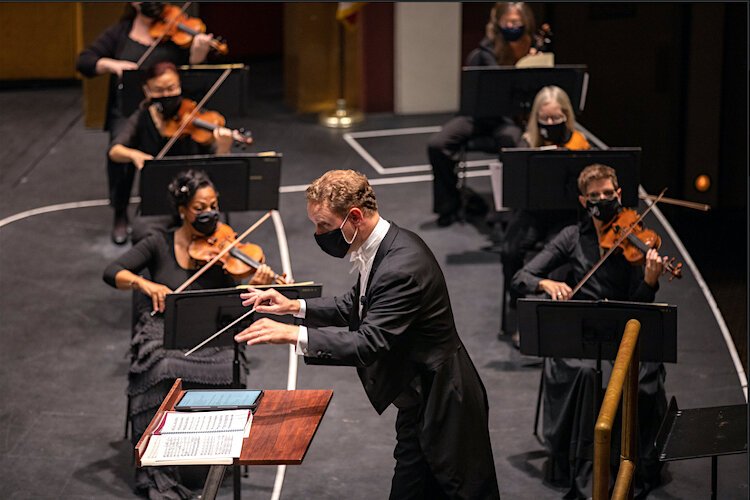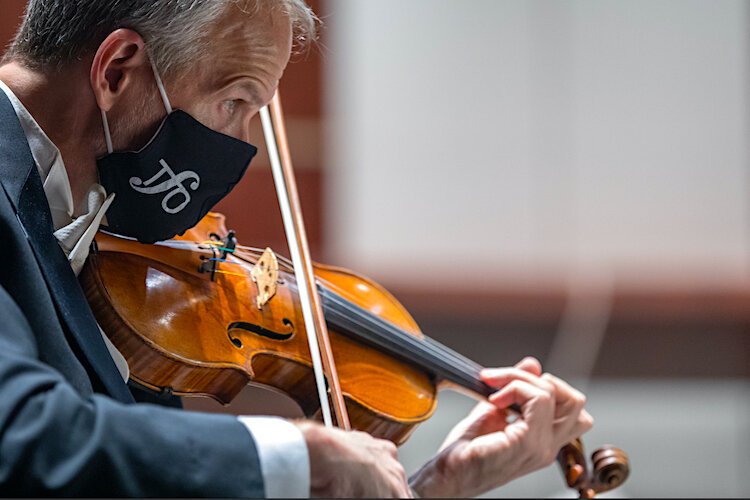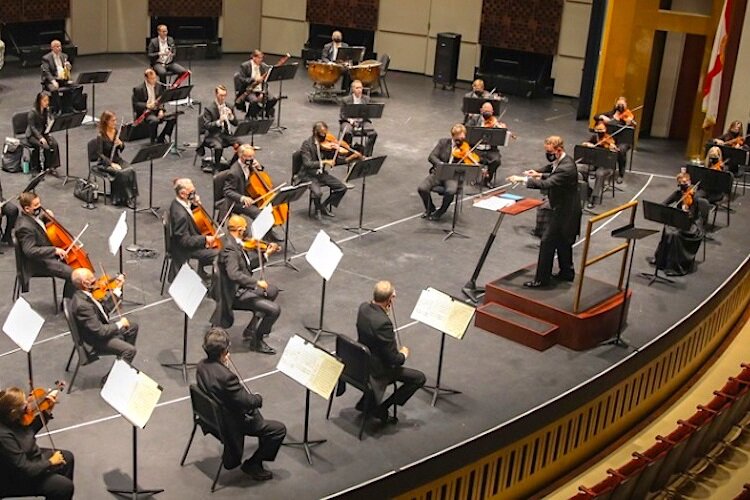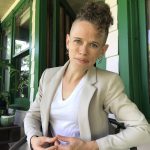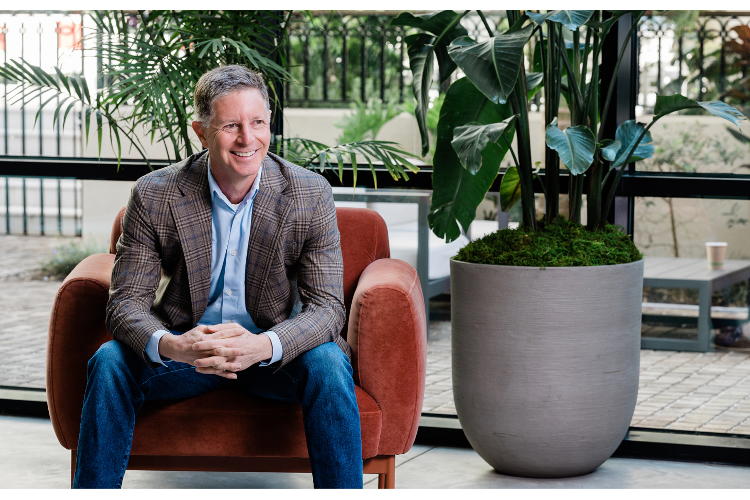Florida Orchestra composes savvy solutions to modulate COVID problem
The Florida Orchestra is back performing live at Mahaffey Theatre in St. Petersburg while observing CDC-recommended social distancing in front of a 25% audience capacity. The concerts are also available online.
Remember when you could easily spend a day wandering an art museum or an evening at a local theater — a time when you were physically present with the art and the artists in your community?
A year after COVID interrupted our lives and made going out and about with friends and family anything but routine, Tampa Bay Area arts institutions persevere. As they always do. But when a deadly virus forces performance spaces and gallery doors to close altogether or limit attendance — how do artists go on creating, performing, and reaching their communities? How do arts institutions survive? How has the interaction and relationship among art, artists, and appreciative audiences changed, in some cases forever?
83 Degrees reached out to the USF Contemporary Art Museum, the Tampa City Ballet, and the Florida Orchestra to learn how they are adapting, evolving, surviving, and, hopefully, thriving. Below is the third in a three-part series.
Everything was going so smoothly a year ago in January. The Florida Orchestra was hitting all the right notes in preparation for its 2020-2021 season — one that promised scores of sonic, dazzling bells and whistles in honor of Ludwig van Beethoven’s 250th birthday; a season that hinged on supersized productions.
The ink was dry on musicians’ contracts. The traditional venues were booked a year out at Mahaffey Theatre, Ruth Eckerd Hall, and the Straz. Florida Orchestra musicians and Master Chorale of Tampa Bay were preparing to tackle some of the great composers’ most complex, demanding, and grandest masterworks.
The season opener, scheduled for early October 2020, would be Beethoven’s Symphony No. 9 — a guaranteed showstopper with the full orchestra on stage. The Master Chorale would join the Orchestra for Ode to Joy in the fourth and final movement. It would be breathtaking.
But then spring arrived, and with it, COVID-19.
“When everything hit,” says Florida Orchestra General Manager Edward Parsons, “we pretty quickly scrapped plans for the coming season. Since then, it has been challenges from almost every angle.”
Spacing out: A socially distanced symphony
With coronavirus’ arrival, performances ground to a halt. It was evident that to err on the side of caution was the only safe choice. But might the Florida Orchestra play on, nonetheless, through a pandemic? The musical institution quickly sought solutions rooted in science.
“We had a COVID-19 task force and we talked with epidemiologists, experts, and other orchestras. We researched what orchestras are doing around the world and looked at research done by places like the University of Minnesota,” Parsons says.
Some findings were unsurprising, but within them, he notes, there was nuance. Take, for instance, the case of the tuba: The instrument acts as sort of a brass maze that confounds the respiratory droplets exhaled by the musician into its main tube, which would extend approximately 18 feet if it were uncoiled.
“By and large, these studies showed that winds, including flute and trumpet, which were the biggest offenders in terms of aerosol production — but even these, still — did not produce significant aerosols beyond three feet. The tuba, because it has several feet of tubing, actually produces no detectable aerosols when playing even within one inch, because they get trapped inside the instrument,” Parsons says.
The orchestra reduced its numbers in adherence to recommendations from studies on musicians’ aerosol production — and added a few extra feet of spacing between wind instrumentalists to be safe.
“Normally, we would have 80 musicians on stage, but social distancing restricts that, now. We had to limit spacing to create six-foot distancing between string musicians and they perform masked. Our wind players are distanced eight feet apart,” Parsons says.
Once the Orchestra ascertained it could, indeed, play on, the next question was: How might the symphony safely reach its audience?
Playing to a quarter of the audience
“I know more about HVAC, now, than I ever thought I would,” Parsons muses.
Thanks to the pandemic, the Florida Orchestra’s general manager says he’s become well-versed in ACH — that’s air changes per hour: the number of times the air circulating through a room (in this instance, performance halls) enters and exits that space.
The Florida Orchestra canceled its Ruth Eckerd and Straz performances. Currently, all performances take place at the Mahaffey Theatre in St. Pete, which operates at a 25% maximum capacity and keeps audience members strictly spaced at all times.
“It’s hard enough at one venue to deal with HVAC, social distancing logistics, and front of house operations, so it takes a little bit of pressure off to maintain just one venue while all this is going on,” Parsons says.
“We’re beyond recommendations, as far as HEPA filters and air exchange rates are concerned. The code for a large space is six ACH, which means the volume of air in the theatre changes out six times every hour. Counting the entire volume of space within Mahaffey Theater, the air is completely exchanged every eight minutes. This reduces the possibility for the exchange of viral spread,” he adds.
Parsons says Mahaffey nears an ACH rate of 10, placing the theater just short of the air exchange standards maintained in infectious disease labs, which operate at 12 ACH.
The Orchestra also reduced concert lengths to 75 minutes, with no intermission, to reduce opportunities for audiences to mingle. To make up for the shortened performances while continuing to utilize all contracted musicians, Florida Orchestra introduced “Soundwaves” in 2020. This series of smaller, more adventurous works takes place on the same day as Masterworks performances — allowing patrons the option to experience multiple performances in one day.
Making music accessible with modern tech
Florida Orchestra recently announced the third and final phase of its reimagined 2020-21 season. All performances will take place both in a limited-capacity Mahaffey, as well as virtually.
In some ways, confronting COVID-19 modernized the Florida Orchestra, and in others, it forced an unanticipated infusion of historical accuracy. Take Beethoven’s Symphony No. 7 — as it was recalibrated with socially distanced musicians for the Orchestra’s current performances:
“Normally, we would do that with 13 first violins — but we’re now doing it with six or seven. When Beethoven performed these pieces, he would have had only six or seven violinists — so in some ways, what we’re doing now is actually more historically accurate,” Parsons says.
Despite the challenges created by limited stage and theater capacity, the Florida Orchestra remains committed to reaching audiences. Like other arts organizations in the Tampa Bay Area, the Orchestra has embraced film- and live-streaming technology as a direct result of the pandemic.
“We engage a video team of five cameras in the performance hall for anyone that is not able to, or not comfortable coming to the hall but wants to maintain a connection to the orchestra. It’s something we’ve been talking about for years, but there are significant costs involved, so it was always hard to justify. But this sort of pushed us into the 21st century — and I don’t expect it’s going to go away,” Parsons says.
“To be able to bring live music to people, even if it’s through their computer or home entertainment system — to keep that sort of vitality of the arts in Tampa Bay going during this hard time — feels like really important work,” he adds.
Since beginning to offer virtual performances for free to the public in 2020, Parsons notes the Florida Orchestra has seen an uptick in donations. That charitable giving, he explains, carries the orchestra. Parsons concludes:
“We’re thankful for our board and membership that we can play at all. Not every orchestra in the U.S. can say that. Many had to shut down entirely in 2020, and there are questions about whether they’ll be able to come back at all. It’s a real testament to our community that we can keep going, that we’re able to compensate musicians and staff, and that we can provide music for the community through this.”
To learn more and find the latest updates about performances, visit the Florida Orchestra website and the Master Chorale of Tampa Bay.
First 2 parts in this 3-part series:
- PPE pirouette: Tampa City Ballet dances with COVID-safe precautions
- Gallery experiences go virtual at the USF Contemporary Art Museum
83 Degrees stories about philanthropy and its impact on the community are supported in part through contributions to the Solutions Journalism Fund set up through the Community Foundation of Tampa Bay. This fund was developed to support solutions journalism and storytelling that will provide information and build awareness designed to grow support for local nonprofits and their missions. The storytelling will focus on how local charities contribute to community building, public health, the arts, and equity issues as it relates to neighborhoods, education, and the environment. If you appreciate this kind of reporting, please consider making a donation by following this link. Any amount helps support solutions journalism. Thank you!

